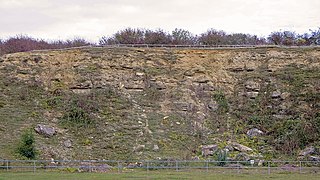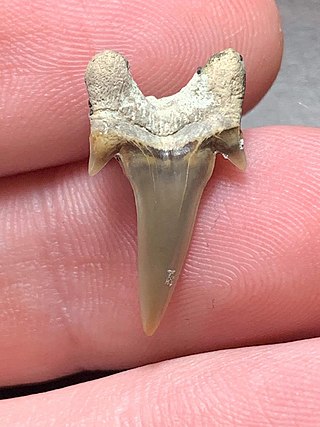
The Lamniformes are an order of sharks commonly known as mackerel sharks. It includes some of the most familiar species of sharks, such as the great white as well as less familiar ones, such as the goblin shark and megamouth shark.

Cretoxyrhina is an extinct genus of large mackerel shark that lived about 107 to 73 million years ago during the late Albian to late Campanian of the Late Cretaceous. The type species, C. mantelli, is more commonly referred to as the Ginsu shark, first popularized in reference to the Ginsu knife, as its theoretical feeding mechanism is often compared with the "slicing and dicing" when one uses the knife. Cretoxyrhina is traditionally classified as the likely sole member of the family Cretoxyrhinidae but other taxonomic placements have been proposed, such as within the Alopiidae and Lamnidae.

Hybodus is an extinct genus of hybodont that lived from the Middle Triassic to the Late Cretaceous periods. Species closely related to the type species Hybodus reticulatus lived during the Early Jurassic epoch. Numerous species have been assigned to Hybodus spanning a large period of time, and it is currently considered a wastebasket taxon that is 'broadly polyphyletic' and requires reexamination.
The Taynton Limestone is a geological formation in Oxfordshire in the United Kingdom. It dates to the Middle Jurassic, mid-Bathonian stage. It predominantly consists of ooidal grainstone. The term "Stonesfield Slate" refers to slaty limestone horizons within the formation that during the 18th and 19th centuries were extensively quarried for use in roof tiling within the vicinity of Stonesfield, Oxfordshire. Previously these were thought to belong to the Sharp's Hill Formation, but boreholes and shaft sections suggest that at least three horizons within the Taynton Limestone were quarried for the slate. These horizons are well known for producing a diverse set of fossils including those of plants, insects as well as vertebrates, including some of the earliest known mammals, pterosaurs as well as those of first dinosaur ever described, Megalosaurus.

The Forest Marble is a geological formation in England. Part of the Great Oolite Group, it dates to the late Bathonian stage of the Middle Jurassic.

Dwardius is an extinct genus of cardabiodontid sharks which existed during the Cretaceous period in what is now Australia, England, France, and India. It was described by Mikael Siverson in 1999, as a new genus for the species Cretalamna woodwardi, which had been described by J. Hermann in 1977. Another species, D. siversoni, was described from the middle Albian of northeastern France by V.I. Zhelezko in 2000; the species epithet honours the author of the genus. A new species, D. sudindicus, was described by Charlie J. Underwood, Anjali Goswami, G.V.R. Prasad, Omkar Verma, and John J. Flynn in 2011, from the Cretaceous Karai Formation of India.
Cretorectolobus is an extinct carpet shark. It was described by G.R. Case in 1978, and the type species is C. olsoni, which existed during the Campanian in Canada and the United States. Another species, C. gracilis, was described by Charlie J. Underwood and Mitchell in 1999, from the Hauterivian to Barremian strata of the Speeton Clay Formation of England. The species epithet refers to the shark's teeth, which Underwood and Mitchell described as gracile and narrow in form. A new species, C. robustus, was described from the Cenomanian of Canada by Underwood and Stephen L. Cumbaa in 2010.
Eostriatolamia is an extinct genus of sharks in the family Odontaspididae. It was described by Gluckman in 1980. A new species, E. paucicorrugata, was described from the Cenomanian of Canada by Charlie J. Underwood and Stephen L. Cumbaa in 2010.

Meristodonoides is an extinct genus of hybodont. The type species is M. rajkovichi, which was originally a species in the genus Hybodus. The species, along with other Hybodus species such as H. butleri and H. montanensis, was reassigned to Meristodonoides by Charlie J. Underwood and Stephen L. Cumbaa in 2010. The species is primarily known from remains from the Cretaceous of North America, spanning from the Aptian/Albian to Maastrichtian, making it one of the last surviving hybodont genera, though records of the genus likely extend as far back as the Late Jurassic, based on an undescribed skeleton from the Tithonian of England, and fragmentary teeth from the Kimmeridgian of Poland, England and Switzerland. Other remains of the genus are known from the Coniacian of England, the Aptian-Albian of France, and the Campanian of European Russia. The morphology of the teeth suggests an adaptation to tearing prey. Fossils from the Western Interior Seaway suggest that it preferred nearshore marine environments, being absent from deeper-water areas, with it likely also being able to tolerate brackish and freshwater conditions.
Roulletia is an extinct genus of sand sharks or Haimirichiid shark. It was described by Romain Vullo, Henri Cappetta, and Didier Néraudeau in 2007, and the type species is R. bureaui, which existed during the upper Cenomanian of what is now France. The genus was named after its type locality, Roullet-Saint-Estèphe, while the species epithet honours Michel Bureau, an amateur paleontologist who gathered the material for the species. Another species, R. canadensis, was described from the Cenomanian of Canada by Charlie J. Underwood and Stephen L. Cumbaa in 2010. The species epithet refers to the country in which it was discovered. It has been suggested tentatively this genus may be related to Haimirichia, which has been placed in its own family (Haimirichiidae) based on soft-tissue preservation.

Sclerorhynchoidei is an extinct suborder of rajiform rays that had long rostra with large denticles similar to sawfishes and sawsharks. This feature was convergently evolved, recently proposed as 'pristification', and their closest living relatives are actually skates. While they are often called "sawfishes", sawskates is a more accurate common name proposed in 2021 for sclerorhynchoids, which has been subsequently used by other researchers.

Synechodontiformes is an extinct order of prehistoric shark-like cartilaginous fish, known from the Permian to the Paleogene. They are considered to be members of Neoselachii, the group that contains modern sharks and rays.
Paleotriakis is a genus of ground sharks that lived in the Late Cretaceous period of France.
This list of fossil fishes described in 2019 is a list of new taxa of jawless vertebrates, placoderms, acanthodians, fossil cartilaginous fishes, bony fishes, and other fishes of every kind that were described during the year 2019, as well as other significant discoveries and events related to paleoichthyology that occurred in 2019.

Archaeolamna is an extinct genus of mackerel sharks that lived during the Cretaceous. It contains three valid species which have been found in Europe, North America, and Australia. While it is mostly known from isolated teeth, an associated set of teeth, jaws, cranial fragments, and vertebrae of A. kopingensis is known from the Pierre Shale of Kansas. Teeth of A. k. judithensis were found with a plesiosaur skeleton with bite marks from the Judith River Formation of Montana. It was a medium-sized shark with an estimated total body length of 3–4 metres (9.8–13.1 ft).
Pseudonotidanidae is an extinct family of prehistoric sharks in the order Hexanchiformes. It was formerly part of the extinct order Synechodontiformes.

Protosqualus was a genus of dogfish shark that existed during the Cretaceous. Fossils have been found in Europe, East Asia, Antarctica, Australia, India and South America. The type species is Protosqualus sigei, which was found around an Albian aged deposit in France. There are 6 species which can be differentiated by distinct features in their teeth. Some species show some level of heterodonty, for example Protosqualus barringtonensis shows a rather high level of heterodonty within its teeth. The oldest specimens are from the Speeton Clay Formation. Protosqualus teeth are quite common in the Grey Chalk deposit of England. The genus went extinct at the end of the Cretaceous during the Cretaceous–Paleogene extinction event, with the last species in the genus being Protosqualus argentinensis from southern Argentina as well as possibly being from earlier deposits in India.









